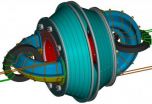(Press-News.org) GAINESVILLE, Fla. — An unusual collaboration between researchers in two disparate fields resulted in a new discovery about the teeth of 65-million-year-old dinosaurs.
With the help of University of Florida mechanical engineering professor W. Gregory Sawyer and UF postdoctoral researcher Brandon Krick, Florida State University paleobiologist Gregory Erickson determined the teeth of hadrosaurs — an herbivore from the late Cretaceous period — had six tissues in their teeth instead of two. The results were published in the journal Science Oct. 5.
"When something has been in the ground 65 million years, by and large we pick it up and we look at it and say, 'oh, look at what has been preserved.' But we don't mechanically interrogate fossils to see if there is other information," Sawyer said. "When we started to mechanically interrogate these teeth, what we found was all of these properties were preserved, and one other thing: these teeth were a lot more complicated than we thought."
For years, Erickson, who has a background in biomechanical engineering and studies bone biomechanics as a paleobiologist, had thought so. So he turned to the UF Tribology Laboratory, which researches the science of friction and surface wear.
Engineers don't often see the interesting paleontological questions, Sawyer said. One look at the surface of the dinosaur teeth piqued his interest, however, because he is intrigued by how wear occurs across surfaces with different materials. The shape of the tooth made him think it was much more complex than previously thought.
From an engineering perspective, Sawyer said his lab often works with composites that contain different material properties that wear differently, so the question was whether just two materials — enamel and dentine — would wear the way the hadrosaur teeth did. Sawyer and Krick thought not, and turned to nanoindenters and microtribometers.
Just a decade ago, a paleontologist might not have asked engineers for help, and they could not have helped him. In the last 10 years, however, Sawyer said advances in engineering — tribology and nanoscience, in particular — make it possible to test more materials, even those millions of years old.
Erickson said reptilian dinosaurs have been dismissed as simplistic creatures in their feeding and dental structure. They were herbivores, their teeth composed of enamel and dentine. The fossil record did little to contradict that.
Testing with nanoindenters and microtribometers, however, proved the conventional wisdom wrong.
"Hadrosaurs' teeth were incredibly complicated, among the most complex of any animal," Sawyer said. "These dinosaurs had developed a lot of tricks."
The duck-billed hadrosaur was a toothy creature with up to 1,400 teeth, Erickson said. The teeth migrated across the chewing surface, with sharp, enamel-edged front teeth moving sideways to become grinding teeth as the teeth matured. The adaptation allowed hadrosaurs to bite off chunks of bark and stems and chew them to a digestible mush, leading Erickson to describe them as "walking pulp mills." The teeth wore down at the rate of 1 millimeter per day, cycling through the jaw like a conveyor belt, before falling out or being swallowed. The dinosaurs lost about 1,800 teeth a year, leaving behind plenty of fossils for testing.
When the fossils emerged from batteries of tests, the researchers found six tissues in the tooth structure, not two.
"Modern tools told us there were different materials in there," said Sawyer, who is also a UF Research Foundation Professor and Distinguished Teaching Scholar.
Erickson said the work could not have been accomplished without Sawyer's lab, "arguably the best tribological lab in the world," and said he is excited about the possibilities for new avenues of research. There are drawers full of fossils in collections around the world that may have more information to yield.
Sawyer agrees, and says that more engineering data could well be buried in fossils.
"Perhaps now it makes sense to take some of that fossil record, when we have other pieces of the record, and start to do things like sectioning and histology," Sawyer said. "There are opportunities now with modern scientific tools to probe their mechanical and tribological properties. If we treat a fossil as a modern material, what happens? Do the mechanical properties track?"
The collaborative nature of the Florida university system was a key to getting the work done, Sawyer said, as was the funding his research gets from the University of Florida Foundation.
"It took us five years to do this because it was always a side project and wasn't funded. We could chew on it at our own pace," Sawyer said. "This is exactly what you hope for when you endow research, that people will take those funds and do things that are scientifically significant."
###
Credits
Writer
Cindy Spence
Contact
W. Gregory Sawyer, wgsawyer@ufl.edu, 352-392-8488
Contact
Brandon Krick, bakrick@ufl.edu, 352-392-0828
Contact
Gregory Erickson, gerickson@bio.fsu.edu END
Researchers work across fields to uncover information about hadrosaur teeth
2012-10-12
ELSE PRESS RELEASES FROM THIS DATE:
Notre Dame researcher helps make Sudoku puzzles less puzzling
2012-10-12
For anyone who has ever struggled while attempting to solve a Sudoku puzzle, University of Notre Dame researcher Zoltan Toroczkai and Notre Dame postdoctoral researcher Maria Ercsey-Ravaz are riding to the rescue. They can not only explain why some Sudoku puzzles are harder than others, they have also developed a mathematical algorithm that solves Sudoku puzzles very quickly, without any guessing or backtracking.
Toroczkai and Ravaz of Romania's Babes-Boylai University began studying Sudoku as part of their research into the theory of optimization and computational complexity. ...
Mug handles could help hot plasma give lower-cost, controllable fusion energy
2012-10-12
Researchers around the world are working on an efficient, reliable way to contain the plasma used in fusion reactors, potentially bringing down the cost of this promising but technically elusive energy source. A new finding from the University of Washington could help contain and stabilize the plasma using as little as 1 percent of the energy required by current methods.
"All of a sudden the current energy goes from being almost too much to almost negligible," said lead author Thomas Jarboe, a UW professor of aeronautics and astronautics. He presents the findings this ...
More than just 'zoning out' -- Exploring the cognitive processes behind mind wandering
2012-10-12
It happens innocently enough: One minute you're sitting at your desk, working on a report, and the next minute you're thinking about how you probably need to do laundry and that you want to try the new restaurant down the street. Mind wandering is a frequent and common occurrence. And while mind wandering in certain situations – in class, for example – can be counterproductive, some research suggests that mind wandering isn't necessarily a bad thing.
New research published in the journals of the Association for Psychological Science explores mind wandering in various ...
Duke Medicine news -- Anti-cancer drug fights immune reaction in some infants with Pompe disease
2012-10-12
DURHAM, N.C. – Adding a third anti-cancer agent to a current drug cocktail appears to have contributed to dramatic improvement in three infants with the most severe form of Pompe disease -- a rare, often-fatal genetic disorder characterized by low or no production of an enzyme crucial to survival.
Duke researchers previously pioneered the development of the first effective treatment for Pompe disease via enzyme replacement therapy (ERT). ERT relies on a manufactured enzyme/protein to act as a substitute for the enzyme known to be lacking in patients with a particular disease. ...
New studies reveal connections between animals' microbial communities and behavior
2012-10-12
Athens, Ga. – New research is revealing surprising connections between animal microbiomes—the communities of microbes that live inside animals' bodies—and animal behavior, according to a paper by University of Georgia ecologist Vanessa O. Ezenwa and her colleagues. The article, just published in the Perspectives section of the journal Science, reviews recent developments in this emerging research area and offers questions for future investigation.
The paper grew out of a National Science Foundation-sponsored workshop on new ways to approach the study of animal behavior. ...
Enzyme triggers cell death in heart attack
2012-10-12
University of Iowa researchers have previously shown that an enzyme called CaM kinase II plays a pivotal role in the death of heart cells following a heart attack or other conditions that damage or stress heart muscle. Loss of beating heart cells is generally permanent and leads to heart failure, a serious, debilitating condition that affects 5.8 million people in the United States.
Now the UI team, led by Mark Anderson, M.D., Ph.D., professor and head of internal medicine at the UI Carver College of Medicine, has honed in on how CaM kinase II triggers heart cell death ...
New treatments for epilepsy, behavioral disorders could result from Wayne State studies
2012-10-12
Three studies conducted as part of Wayne State University's Systems Biology of Epilepsy Project (SBEP) could result in new types of treatment for the disease and, as a bonus, for behavioral disorders as well.
The SBEP started out with funds from the President's Research Enhancement Fund and spanned neurology, neuroscience, genetics and computational biology. It since has been supported by multiple National Institutes of Health-funded grants aimed at identifying the underlying causes of epilepsy, and it is uniquely integrated within the Comprehensive Epilepsy Program at ...
Safety results of intra-arterial stem cell clinical trial for stroke presented
2012-10-12
HOUSTON – (Oct. 11, 2012) – Early results of a Phase II intra-arterial stem cell trial for ischemic stroke showed no adverse events associated with the first 10 patients, allowing investigators to expand the study to a targeted total of 100 patients.
The results were presented today by Sean Savitz, M.D., professor of neurology and director of the Stroke Program at The University of Texas Health Science Center at Houston (UTHealth), at the 8th World Stroke Congress in Brasilia, Brazil.
The trial is the only randomized, double-blind, placebo-controlled intra-arterial clinical ...
Satellite sees 16th Atlantic tropical depression born near Bahamas
2012-10-12
The 16th tropical depression of the Atlantic Ocean season has formed northeast of the Bahamas and NOAA's GOES-14 satellite captured a visible image of the storm as it tracks to the southwest.
NOAA's GOES-14 satellite captured a visible image of newborn Tropical Depression 16 (TD16) near the Bahamas on Oct. 11 at 7:45 a.m. EDT. TD16 appeared as a rounded area of clouds just northeast of the Bahamas and its western fringes were just off the Florida east coast. GOES-14 also showed another low pressure area with the potential for development a few hundred miles from the Windward ...
NASA sees Typhoon Prapiroon doing a 'Sit and Spin' in the Philippine Sea
2012-10-12
As Typhoon Prapiroon slowed down and became quasi-stationary in the Philippine Sea NASA's Terra satellite passed overhead and captured an image of the storm.
NASA's Terra satellite passed over Typhoon Prapiroon on Oct. 11 at 0210 UTC (1010 p.m. EDT, Oct. 10) and the Moderate Resolution Imaging Spectroradiometer (MODIS) instrument captured a visible image of the storm. The visible imagery clearly showed a small ragged eye, and microwave satellite imagery confirmed the eye. Satellite imagery also confirmed a well-defined low-level center of circulation.
By 11 a.m. EDT ...


